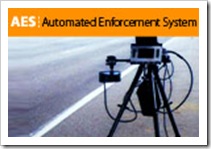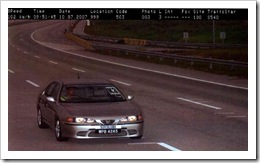Automated Enforcement System (AES) Location
Automated Enforcement System(AES) was started today!
Therefore, you may get summons notice if you beat the red lights(jump traffic lights) or/and break the speed limit within a week!
The good things the installed at locations(Accident prone black spots) are made know to the public through signboards. The signboards was visible from 2km to 3km before the cameras location.
In the first phase, there are 14 cameras which have been installed in Kuala Lumpur, Selangor, Putrajaya and Perak.
Majority of them are to nab drivers who break the speed limit(10 units) and jump traffic lights(4 units). All the cameras works 24X 7 X 360 in all weather!
According to Datuk Solah Mat Hassan, Road Transport Department (JPJ) director-general, more cameras will be installed at 817 “blackspots” in the second phase which complete the AES nationwide implementation.
This is in line with the Government objective to reduce the number of road fatalities in locations which recorded high road accident death rates.
For those who get caught with the AES, they will get their summons notices within five days of the date they violate traffic rules.
This is a good move as many did not received any summons notices. They realise got summons after checking online or get blacklisted when renew the licence.
Those who got the summons notices and have enquiries may contact AES Control Centre below:
Offences Committed in:
1) Selangor, Putrajaya and Kuala Lumpur-03-7628 8268
2) Perak – 03-7846 4400
Automated Enforcement System (AES) Location
.
AES on target to catch speeding motorists
.
The Automated Enforcement System (AES) could be catching speeding motorists as soon as August.
.
.
The Automated Enforcement System (AES)
.
Automated Enforcement System (AES) will begin its trial run on August 12
.
Mahfuz: Jangan bayar saman AES


Leeway given to drivers under Automated Enforcement System
When the light turns amber, you have just two seconds before it turns red and the cameras catch you committing a traffic offence under the Automated Enforcement System.
This allowance is given in consideration of the “human element” in the event that you are not able to stop immediately when the light turns amber.
Under the AES, you are also given a leeway of 10kph beyond the speed limit, according to Road Transport Department director-general Datuk Solah Mat Hassan.
For example, if the speed limit is 110kph, you will only be “captured” on AES camera if you exceed 120kph, he told a media briefing here yesterday.
“Thus, offenders can no longer argue they only drove a couple of kilometres over the speed limit or that the traffic light turned red halfway.”
Solah also said the system started on Sunday with 14 cameras installed at accident-prone areas in Perak, Selangor, Putrajaya and Kuala Lumpur 10 to catch speed limit breakers and four to nab those who beat the red light.
In those two days, 2,952 offenders were caught on camera 809 for speeding and 2,143 for beating the red light, he added.
Solah said that cameras would be installed at 817 blackspots nationwide in the next one year.
He said the cameras, with an 11 megapixel resolution, could capture clear images of vehicles even when they were moving at high speed.
“The images captured will be sent automatically to the AES control centre and the vehicle registration numbers of the offenders will be cross-checked with the database of the Road Transport Department before a summons notice is mailed to the vehicle owner.
“Offenders will receive their summons notice within five days of the date they violated traffic rules. They are given two months to pay their RM300 compounds. They can be hauled to court if they refuse to pay up,” he said.
Solah stressed that the AES was not aimed at issuing summonses, but to educate people to be good road users and reduce the number of deaths due to accidents in the country.
As such, he said, signages were put up to give ample warning on the presence of cameras.
Two concessionaire companies, ATES Sdn Bhd and Beta Tegap Sdn Bhd, operate AES, each investing between RM300mil and RM400mil.
fr:thestar.com.my/news/story.asp?file=/2012/9/26/nation/12081738&sec=nation
JPJ: Adequate signs in place to warn motorists of AES
There are adequate signs to warn motorists of the Automated Enforcement System (AES) cameras at 14 locations nationwide, said Road Transport Department (JPJ) deputy director-general Datuk Ismail Ahmad.
In refuting motorists’ claims of inadequate signs leading up to the speed cameras, he said they were prominently displayed.
“The signboards are located between 2km and 3km from the cameras that capture images of speeding vehicles.
“For cameras that record motorists running red lights, the signs are located between 50m and 500m from the traffic lights,” he said.
He added that the signs could be seen clearly even at night.
Ismail reiterated that the AES was not aimed at issuing summonses, but to reduce speeding and jumping a red light.
The AES went online on Sept 23, with 14 cameras installed in Perak, Selangor, Putrajaya and Kuala Lumpur.
Ten of the cameras are aimed at nabbing those who break the speed limit while the other four will catch motorists who jump the red light.
In just two days, 2,952 offenders were caught on camera 809 for speeding and 2,143 for beating the red light.
More cameras will be installed at 817 blackspots nationwide next year.
To check the AES camera locations, log on to JPJ’s web site
fr:thestar.com.my/news/story.asp?file=/2012/10/5/nation/12126862&sec=nation
Only JPJ will issue summonses against errant road users caught by AES
Summonses against errant road users caught by the Automated Enforcement System (AES) will only be issued by the Road Transport Department (JPJ) after verification.
Deputy Transport Minister Datuk Abdul Rahim Bakri told the Dewan Rakyat that ATES Sdn Bhd and Bina Tegap Sdn Bhd the two companies appointed to install the cameras were not tasked with issuing summonses.
“Since the implementation of AES on Sept 23, 63,558 images of motorists purportedly committing traffic offences have been captured.
“However, the JPJ is in the midst of determining whether those offences were actually committed.
“Therefore, no summonses have been issued,” he said in response to a question by Dr Lee Boon Chye (PRK-Gopeng).
He said the rate of return for the two companies was capped at 17%, adding that they would be paid in three ways, including RM16 per valid summons up to five million summonses.
“The aim of implementing the AES is to instil the perception of being caught among motorists, which is now between 25% and 45%.
“Our target is that the perception will reach 70% to 90%,” he said.
Rahim added that the AES had a positive impact, citing an example where 50 motorists were caught beating the red light at Km28 Jalan Ipoh-Kuala Kangsar in Sungai Siput within the first three days of implementation.
It is learnt that the JPJ has already started issuing summonses to errant motorists.
fr: thestar.com.my/news/story.asp?file=/2012/10/5/nation/12126186&sec=nation
AES figures are staggering
Posted on 8 October 2012 – 07:59pm
IT WAS reported that 63,558 offences were captured by 14 cameras over eight days under the Automated Enforcement System (AES).
Therefore, on average, each camera recorded 567 offences a day or one in every two and a half minutes. At this rate, a staggering 171,772,650 offences will be captured in a year when all 830 cameras are used.
Can the Road Transport Department issue such a huge number of summonses and are motorists willing to pay?
Laws and rules are meant to protect the majority. If a huge number is penalised, then something must be wrong and ought to be changed.
A good example is the two-second rule. Motorists would be in a Catch-22 situation upon reaching traffic lights turning amber.
Motorists who dash across risk being caught on camera and collisions can easily occur when drivers behind expect the drivers in front to step on the accelerator and not the brake pedal.
As such, the AES would cause more crashes unless digital counters are installed at traffic lights as signboards would not be enough.
Super cars are treated the same as jalopies as the cameras cannot discriminate between vehicles. Yet in most instances, it would be no more dangerous for a German car to cruise at 160kph than a 660cc car floating at 110kph.
It would be interesting to know how the cameras are able to differentiate between private and commercial vehicles that have lower speed limits.
Would speed cameras be able to capture speeding motorcycles from behind as their number plates may not be visible from the front?
Y.S. Chan
Kuala Lumpur
fr:thesundaily.my/news/510264